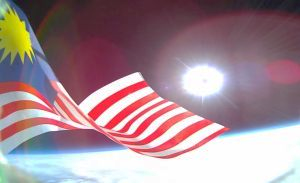Research
1. Near Space
Near Space Research is to explore further on what actually occurs in the atmosphere of the earth. This research is to expose and encourage especially student and youth to have fun with learning throughout the finding.
There are many projects that were included in this research. The projects are High Altitude Balloon (HAB), Small Satellite System - MYSat and CanSat(CaKEd), and also the Ground Station development.
High Altitude Balloon (HAB)
The near space research focuses on the development of High-altitude balloons (HAB) system. HAB are unmanned balloons, usually filled with helium or hydrogen that is released into the stratosphere, generally reaching a height of between 60,000 to 120,000 feet (18 to 37 km). The most familiar type of high altitude balloons is weather balloons. HAB can be used as a platform for experiments in the upper atmosphere and in future this system potentially become transportation for space tourism. Research on HAB includes:
a) Autonomous payload retrieval system
b) Balloon and valve system
c) Communication system

Small Satellite System
The Near Equatorial Orbit (NEqO) is one of niche orbit that can be utilized by Malaysia. The advantage to placing a satellite on NEqO is on the higher revisit of satellites, as compared to other orbits, hence increasing the potential use for various monitoring and surveillance applications. The research includes studying the environment of NEqO in order to come out with the details of NEqO characterisations (radiation, high energetic particle, etc) and models of NEqO environment for various applications. Development of small satellite is part of the research to develop capability in building an operational satellite. The study is also inclusive of satellite integration and testing.
Current Project:
a) Development of MYSat – University’s 1U CubeSat
b) Development of CanSat Kit for Education (CaKEd)
For further information: Dr. Norilmi Amilia Ismail
2. Space Environment
The Earth’s ionosphere and magnetosphere consists of partially ionized plasma extracted in the ionosphere regions and immersed into Earth’s magnetic field. The low-frequency electrodynamics waves in ULF band that are generated by the interaction between solar wind and geomagnetic field propagate across the ambient magnetic field and spread wave energy all over the magnetosphere (Alperovich LS et.al 2007).
The ionosphere is divided into 4 regions, depends on their electron density, which are;
a) D region (60-90 km)
b) E region (90-140 km)
c) F1 region (140-200 km)
d) F2 region (200-500 km)
Over a decade, a few techniques have been proposed to study, monitoring, observing and investigating the Earth’s ionosphere and geomagnetic field. Still, numerical and computer modeling is also not able to perform rigorous and more realistic analysis of the electrodynamics of Earth’s ionosphere and geomagnetic field. Our research interest is to develop FDTD method by solving full vector of Maxwell’s equations in order to model details global Earth-ionosphere wave guide. The model will be applied to investigate ionospheric anomalies over the Malaysia region that near to Sumatra earthquake epicenter and analyse the VLF-LF band geomagnetic change associated with the earthquake. The comparative study with the experimental data will be done to verify and validate the results from the numerical study.
Current Project:
a) Modeling of the effect of electromagnetic phenomena in ionosphere over South East Asia region
For further information: Siti Harwani Md Yusoff
3. Control and Dynamics
For further information: Ir Dr. Nurulasikin Mohd Suhadis
